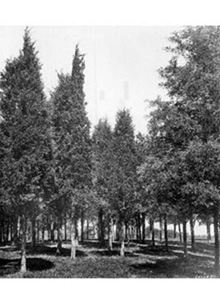
I am trying to find out what constitutes “old growth.” Why would a 100-year-old tree produce “better” wood than a 50-year-old tree? Or even a 25-year-old tree? I think I have read that the growth rings are closer together on the old growth, but I don’t understand why that’s the case. What makes the growth rings vary in a given tree? I have seen stumps where the growth rings vary in number per inch. What causes the variation? Is wood with more growth rings stronger than wood with less growth rings per inch?
Michael Dresdner: “You’ve got three distinct questions here. The first is about old growth timber, the second concerns the spacing of growth rings, and the third asks the effect of tighter or looser growth rings. Let’s take them separately.
Old growth is a term used for certain woods that produce different characteristics in the later growth of older trees. A good example is old growth western red cedar. After about 80 years of growth, the tree starts to produce a chemical that makes the wood resistant to bugs, mold, and infestation. Typically, old trees (200 years and up) lose their core as it rots out, since the first decades of growth lack this protective substance. Hence, the tree, when cut, looks more or less like a hollow cylinder. The outer ring that is left standing is impregnated with the tree’s natural protective chemical. This “old growth” wood is highly desirable for exterior uses, such as roof shingles, decking, and fences, since it is quite impervious to rot and infestation.
Tighter growth rings, on the other hand, are simply an indication of how quickly or slowly the tree grew. If the growing season is short, due to a long winter and short summer, the rings are tighter and closer together. Some species grow more quickly, and have larger rings, but even trees of the same species will have tighter rings if they grow closer to the tree line (higher up a mountain) than those growing in a warmer, wetter valley. In other words, as with real estate, location has a lot to do with it. Variances can occur within the same tree due to the fact that some years the winter is longer and harsher, while other years, winters are milder with longer summer growth seasons. In other words, location, seasonal variance, and species all contribute to the differences.
As for strength, it is not necessarily the case that smaller rings mean more strength. In some species, it can be the opposite, and in some, it has no effect whatever. Strength and stability (resistance to warping) are affected more by the type of wood and how the boards are cut from the tree (slab cut vs. quartered). It is possible that some of these beliefs came from musical instrument makers. One common misconception in the guitar making business is that tighter grain on the spruce tops of flattop guitars yields better sound, more stiffness, or better stability. When tested under laboratory conditions, none of these beliefs are true, though they are still strongly held by many guitar makers.
Rob Johnstone: While I don’t have a thing to add to Michael’s answer, if you would like to try working old growth timber without bothering your conscience, there is a great option available. There is salvaged wood (timber re-sawn from beams salvaged from old buildings) available. These buildings were often constructed with old growth lumber because & that was the only kind of lumber around at the time. (I was in an old barn down in Iowa and said to the farmer ‘If I didn’t know better, I say this barn was built out of black walnut.’ ‘It is black walnut’ was his simple reply.) There is also a supply of lumber harvested at the turn of the century or earlier that sank to the bottom of lakes or rivers and is now being pulled up and sold. I’ve seen some stunning pieces of ‘Lake Superior’ birch, hard maple and several oak species. There is a bit of an environmental question about this lumber being pulled up from the silted areas of lakes and rivers, thus causing water quality degradation. But it is still great wood.





